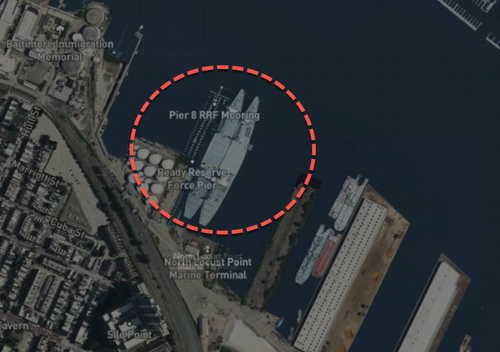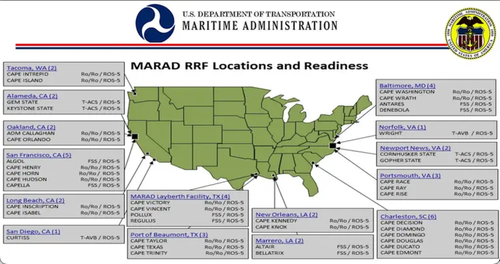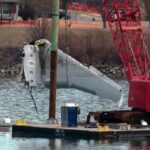
Two high-speed military cargo ships are stuck in the Port of Baltimore following Tuesday morning's collapse of the 1.6-mile-long Francis Scott Key Bridge. The major US East Coast port has been paralyzed for several days as the bridge collapse prevents inbound and outbound vessel traffic along the harbor's channel.
Using the automatic identification system, or AIS, data that tracks commercial vessels, three bulk carriers, two general cargo ships, one vehicle carrier, one tanker, and four Ready Reserve Force vessels (RRF), along with the container ship Dali that struck the bridge, are trapped in the harbor, according to the shipping blog gCaptain.
The three bulk carriers include:
-
The Liberian-flagged JY River, owned by JIADE INTERNATIONAL SHIP and managed by WAH KWONG SHIP MANAGEMENT HK of Hong Kong.
-
The Thailand-flagged Phatra Naree, owned by PRECIOUS STONES SHIPPING LTD and managed by PRECIOUS SHIPPING PCL of Thailand.
-
The Portuguese-flagged Klara Oldendorff, owned and managed OLDENDORFF CARRIERS GMBH & CO of Germany.
The vehicle carrier is:
- The Swedish-flagged Carmen, owned by WALL RO/RO AB and managed by WALLENIUS MARINE AB of Sweden.
The general cargo ships include:
-
The French-flagged Saimaagracht, owned by REDERIJ SAIMAAGRACHT and managed by SPLIETHOFF'S BEVRACHTINGS BV of the Netherlands.
-
The Panama-flagged Balsa 94, owned by EASTERN CAPITAL MARINE INC and managed by HIONG GUAN NAVEGACION CO LTD of Hong Kong.
The tanker is:
- The Marshall Islands-flagged Palanca Rio, owned by MINSHENG RUIYANG TIANJIN SHPG and managed by PUMA ENERGY SUPPLY & TRADING of Singapore.
The US Maritime Administration (MARAD) Ready Reserve Force vessels include:
- The Cape Washington, a Cape W Class roll-on/roll-off vessel.
- The Gary I. Gordon, a Gordon-class roll-on/roll-off vessel.
- The SS Antares (T-AKR-294), a Algol-class fast sealift vehicle cargo ship.
- The SS Denebola (T-AKR-294), another Algol-class fast sealift vehicle cargo ship.
According to the military blog The War Zone (TWZ), Algol class vessels are "some of the fastest cargo vessels of their general size anywhere in the world." These ships are part of the RRF, a subset of vessels within MARAD's National Defense Reserve Fleet (NDRF) that provide surge sealift capability to the Pentagon for overseas conflicts.
TWZ said the activation process of RRF vessels takes about five to ten days. The vessels are operated with a skeleton crew until called upon.
RRF are stationed at major marine ports around the US.
TWZ noted the Algol class vessels have been called into action several times over the last three decades:
Algol class have been called upon multiple times since they entered US service. Just five of these ships were responsible for transporting 20 percent of US cargo sent from the United States to Saudi Arabia during the first phase of Operation Desert Shield in the immediate run-up to the First Gulf War. The ships would go on to deliver 13 percent of all cargo that arrived in Saudi Arabia from the United States in the full course of that conflict.
The US military subsequently used Algols to support operations in Somalia and the Balkans in the 1990s, as well as the opening phases of the wars in Afghanistan and Iraq in the early 2000s.
Breitbart News' Kristina Wong reported on Thursday that "The Department of Transportation will not say how many National Defense Reserve Fleet Ships are Stuck" in the Baltimore harbor.
Baltimore Bridge Mess: DOT Will Not Say How Many National Defense Reserve Fleet Ships Stuck https://t.co/Nz7FPPQ2QT via @BreitbartNews
— Kristina Wong 🇺🇸 (@kristina_wong) March 28, 2024
Wong quoted John Konrad, CEO of gCaptain, who warned the stuck RRF vessels are a "huge problem if a war starts [but] not much of a problem if the next few months are peaceful."
According to CEO of GCaptain and maritime journalist@johnkonrad, four Ready Reserve Force ships are stuck in the port — the SS Antares, MV Cape Washington, MV Gary I. Gordon, and the SS Denebola.
— Kristina Wong 🇺🇸 (@kristina_wong) March 28, 2024
He said the four ships being stuck is a “huge problem if a war starts [but] not… https://t.co/4GOZHtuWPE
The current readiness of the RRF fleet is unknown. And just like that, part of America's RRF fleet was taken out not by a missile or suicide drone, but a container ship that allegedly suffered a catastrophic 'electric issue'. America's enemies are taking note.
Two high-speed military cargo ships are stuck in the Port of Baltimore following Tuesday morning’s collapse of the 1.6-mile-long Francis Scott Key Bridge. The major US East Coast port has been paralyzed for several days as the bridge collapse prevents inbound and outbound vessel traffic along the harbor’s channel.
Using the automatic identification system, or AIS, data that tracks commercial vessels, three bulk carriers, two general cargo ships, one vehicle carrier, one tanker, and four Ready Reserve Force vessels (RRF), along with the container ship Dali that struck the bridge, are trapped in the harbor, according to the shipping blog gCaptain.
The three bulk carriers include:
-
The Liberian-flagged JY River, owned by JIADE INTERNATIONAL SHIP and managed by WAH KWONG SHIP MANAGEMENT HK of Hong Kong.
-
The Thailand-flagged Phatra Naree, owned by PRECIOUS STONES SHIPPING LTD and managed by PRECIOUS SHIPPING PCL of Thailand.
-
The Portuguese-flagged Klara Oldendorff, owned and managed OLDENDORFF CARRIERS GMBH & CO of Germany.
The vehicle carrier is:
- The Swedish-flagged Carmen, owned by WALL RO/RO AB and managed by WALLENIUS MARINE AB of Sweden.
The general cargo ships include:
-
The French-flagged Saimaagracht, owned by REDERIJ SAIMAAGRACHT and managed by SPLIETHOFF’S BEVRACHTINGS BV of the Netherlands.
-
The Panama-flagged Balsa 94, owned by EASTERN CAPITAL MARINE INC and managed by HIONG GUAN NAVEGACION CO LTD of Hong Kong.
The tanker is:
- The Marshall Islands-flagged Palanca Rio, owned by MINSHENG RUIYANG TIANJIN SHPG and managed by PUMA ENERGY SUPPLY & TRADING of Singapore.
The US Maritime Administration (MARAD) Ready Reserve Force vessels include:
- The Cape Washington, a Cape W Class roll-on/roll-off vessel.
- The Gary I. Gordon, a Gordon-class roll-on/roll-off vessel.
- The SS Antares (T-AKR-294), a Algol-class fast sealift vehicle cargo ship.
- The SS Denebola (T-AKR-294), another Algol-class fast sealift vehicle cargo ship.
According to the military blog The War Zone (TWZ), Algol class vessels are “some of the fastest cargo vessels of their general size anywhere in the world.” These ships are part of the RRF, a subset of vessels within MARAD’s National Defense Reserve Fleet (NDRF) that provide surge sealift capability to the Pentagon for overseas conflicts.
TWZ said the activation process of RRF vessels takes about five to ten days. The vessels are operated with a skeleton crew until called upon.
RRF are stationed at major marine ports around the US.
TWZ noted the Algol class vessels have been called into action several times over the last three decades:
Algol class have been called upon multiple times since they entered US service. Just five of these ships were responsible for transporting 20 percent of US cargo sent from the United States to Saudi Arabia during the first phase of Operation Desert Shield in the immediate run-up to the First Gulf War. The ships would go on to deliver 13 percent of all cargo that arrived in Saudi Arabia from the United States in the full course of that conflict.
The US military subsequently used Algols to support operations in Somalia and the Balkans in the 1990s, as well as the opening phases of the wars in Afghanistan and Iraq in the early 2000s.
Breitbart News’ Kristina Wong reported on Thursday that “The Department of Transportation will not say how many National Defense Reserve Fleet Ships are Stuck” in the Baltimore harbor.
Baltimore Bridge Mess: DOT Will Not Say How Many National Defense Reserve Fleet Ships Stuck https://t.co/Nz7FPPQ2QT via @BreitbartNews
— Kristina Wong 🇺🇸 (@kristina_wong) March 28, 2024
Wong quoted John Konrad, CEO of gCaptain, who warned the stuck RRF vessels are a “huge problem if a war starts [but] not much of a problem if the next few months are peaceful.”
According to CEO of GCaptain and maritime journalist@johnkonrad, four Ready Reserve Force ships are stuck in the port — the SS Antares, MV Cape Washington, MV Gary I. Gordon, and the SS Denebola.
He said the four ships being stuck is a “huge problem if a war starts [but] not… https://t.co/4GOZHtuWPE
— Kristina Wong 🇺🇸 (@kristina_wong) March 28, 2024
The current readiness of the RRF fleet is unknown. And just like that, part of America’s RRF fleet was taken out not by a missile or suicide drone, but a container ship that allegedly suffered a catastrophic ‘electric issue’. America’s enemies are taking note.
Loading…






